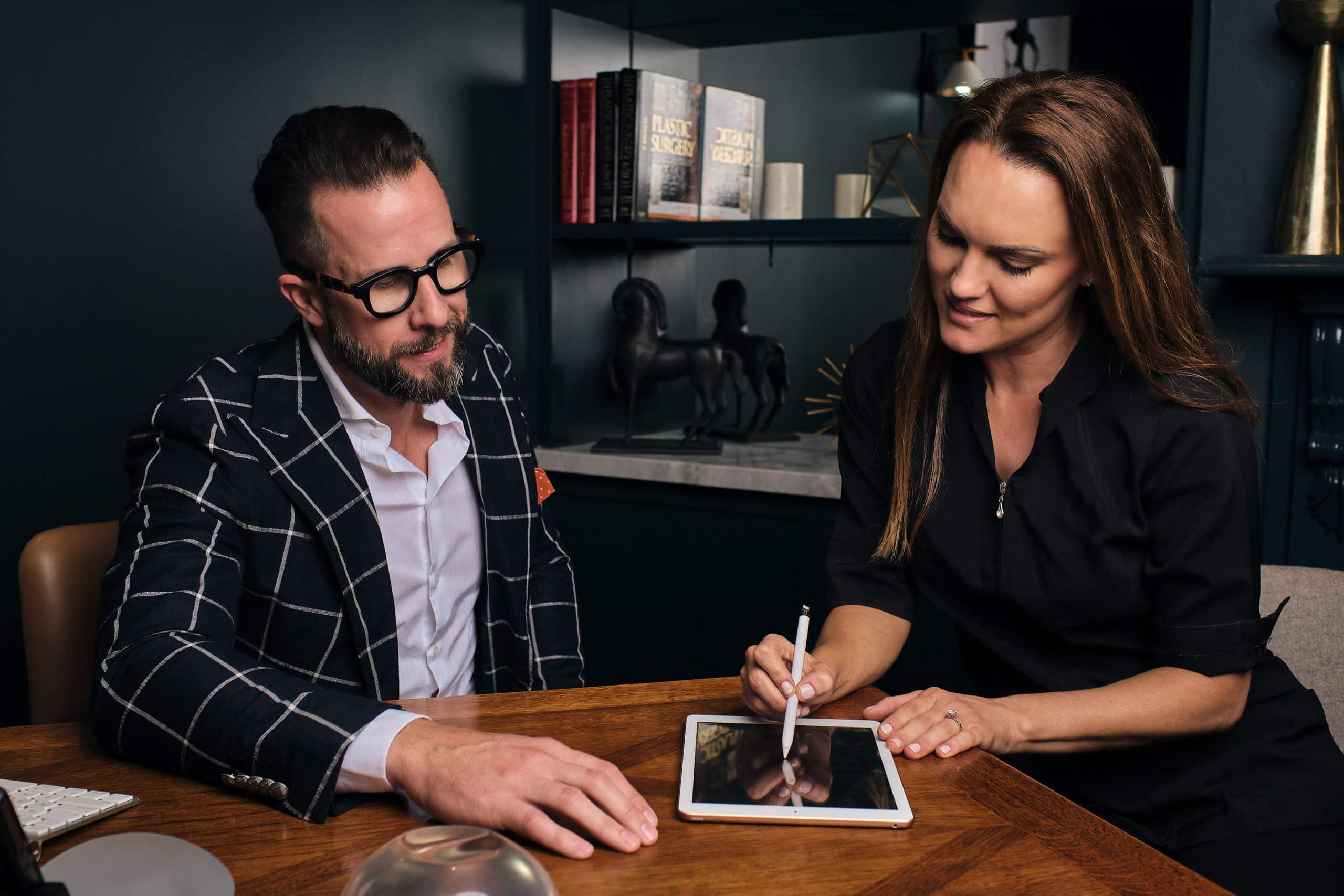Understanding the Risks and Complications of Plastic Surgery
While many people undergo plastic surgery without experiencing any significant issues, it’s crucial to understand and consider these potential risks before making a decision. Here are some complications that could occur after your plastic surgery intervention:
Infection
One of the most common complications after any surgery is infection. Symptoms of an infection can vary depending on the severity, but commonly include redness, swelling, increased pain, and pus or discharge from the surgical wound. Fever or chills may also indicate a systemic infection. Prompt treatment of surgical infections is crucial to prevent complications, and typically involves the use of antibiotics. In severe cases, additional surgery may be necessary to clean the wound. To minimise the risk of infection, strict sterile protocols are followed in the operating room, and patients may be prescribed prophylactic antibiotics. After surgery, patients are advised to keep the wound clean and dry, and to report any signs of infection to their surgeon immediately.
Visible Scarring
While plastic surgery often aims to enhance aesthetics, it’s a surgical procedure that involves incisions, which naturally lead to scarring. Skilled surgeons like Dr. Watts can minimise and strategically place the incisions, but some degree of scarring is unavoidable.
Haematoma
A haematoma is a pocket of blood that resembles a large, painful bruise. Most haematomas disappear without additional treatment. However, in some cases haematomas might require additional surgeries for proper drainage.
Seroma
A seroma is a condition that can occur after a surgical procedure, where a pocket of clear serous fluid develops under the surface of the skin. This fluid, a byproduct of the body’s inflammatory response to surgery, accumulates in areas where tissue has been removed. While seromas can occur after any surgery, they are particularly common following procedures that involve significant tissue disruption, such as body contouring surgeries, breast augmentation, or mastectomies. Symptoms may include swelling, tenderness, or a fluid-filled bulge in the surgical area. While small seromas may be reabsorbed by the body and resolve on their own, larger ones may require medical intervention such as needle aspiration or the use of drains. To reduce the risk of seroma, surgeons may place temporary drains.
Anaesthesia Complications
Anaesthesia is critical for ensuring comfort and pain control during surgeries, but it can also lead to complications. These can range from minor reactions like nausea and vomiting to more serious issues like heart problems or even stroke.
Deep Vein Thrombosis
Deep Vein Thrombosis (DVT) is a serious condition that can occur following surgical procedures, including plastic surgery. DVT refers to the formation of a blood clot, or thrombus, in the deep veins of the body, usually in the legs. This condition can result in significant discomfort and swelling in the affected area. However, the primary concern with DVT is the risk of a pulmonary embolism, a potentially life-threatening event that occurs if the blood clot dislodges, travels through the bloodstream, and blocks a vessel in the lungs. Symptoms of DVT can include swelling, pain, and warmth over the vein in the affected leg, but sometimes there may be no symptoms at all. To minimise the risk of DVT, surgeons employ various strategies such as using compression devices on the legs during surgery, encouraging early mobilisation after surgery, and in some cases prescribing blood-thinning medications.
Pain
Pain after plastic surgery is a common and normal part of the recovery process. The intensity and duration of this pain can vary widely based on the specific procedure performed, the patient’s pain tolerance, and the effectiveness of pain management strategies. Immediately following surgery, patients may experience acute pain due to tissue trauma and inflammation, but this is managed with medications. As the healing process progresses, the pain should gradually diminish. However, persistent or severe pain may indicate a complication, such as an infection or a haematoma, and should be reported to the surgeon immediately. Good communication with your surgical team can ensure that post-operative pain is effectively managed and does not hinder the recovery process.
Minimising the Risks and Complications of Plastic Surgery
While these risks and potential complications might sound alarming, it’s important to remember that they are relatively rare, and there are several ways to minimise them:
- Choose an experienced specialist plastic surgeon: The first step in minimising risks is to choose a reputable, specialist plastic surgeon like Dr. Guy Watts
- Follow pre and post-operative instructions: Your surgeon will provide detailed instructions for before and after the surgery. These might include dietary restrictions, medications to avoid, and guidelines for physical activity. Adhering to these instructions is crucial for minimising risks
- Maintain a healthy lifestyle: A healthy body can better cope with the stress of surgery and recover more effectively. Eating a balanced diet, getting regular exercise, and avoiding habits like smoking can significantly reduce the risk of complications
- Open communication with your surgeon: Ensure you have a detailed discussion with your surgeon about the potential risks and complications associated with the procedure. This open dialogue allows your surgeon to tailor the procedure and care plan to your specific needs, which can help to minimise potential risks
- Don’t smoke: Avoiding smoking can make all the difference between a successful recovery and experiencing complications after your plastic surgery procedure
Specific Risks and Complications Associated with Breast Surgery
Breast surgery, whether it’s for augmentation, reduction, or lift, has its own specific set of potential complications. Here are some complications that may occur:
- Capsular contracture: This is a complication specific to breast implant surgery, where the scar tissue or capsule that normally forms around the implant tightens and squeezes the implant, leading to a hard and possibly misshaped breast
- Implant rupture or leakage: Implants, whether they’re filled with saline or silicone, can rupture or leak. This might be due to the natural aging of the implant, a defective implant, or an external force (like a hard blow to the chest). The consequences and treatment depend on the type of implant and the nature of the rupture
- Changes in sensation: Some women experience changes in nipple or breast sensation following surgery, which can range from increased sensitivity to numbness. While these changes are often temporary, in some cases, they can be permanent
- Asymmetry: The human body is naturally asymmetric, and while surgeons strive for symmetry in breast surgeries, sometimes differences in the shape, size, or position of the breasts can occur post-operatively
- Breastfeeding difficulties: Some surgical procedures, particularly those that involve incisions around the areola, can potentially impact the ability to breastfeed
- BIA-ALCL: This is a rare but serious complication associated specifically with certain types of textured breast implants. Breast Implant-Associated Anaplastic Large Cell Lymphoma (BIA-ALCL) is a type of non-Hodgkin’s lymphoma (cancer of the immune system)
Specific Risks and Complications Associated with Body Contouring Surgery
Body contouring surgeries, such as liposuction, tummy tucks (abdominoplasty), and body lifts, can transform a person’s silhouette, but they also come with specific potential complications. Here are some to be aware of:
- Skin irregularities and changes in skin sensation: Changes in the feel of your skin and numbness are common after liposuction but usually temporary. However, there may be permanent changes or slight differences in the texture and sensation of the skin
- Poor wound healing: This can lead to visible scarring or tissue loss. Patients who smoke or have pre-existing health conditions like diabetes are at higher risk of poor wound healing
- Skin discolouration: In some cases, patients might experience changes in skin colour
- Prolonged swelling: Patients might be confronted with extended periods of swelling
- Unsatisfactory results: There’s a risk that the results might not meet the patient’s expectations. This could include uneven contours, irregular skin, or persistent fat deposits
- Seroma
- Haematoma
- Asymmetry
- Deep vein thrombosis and pulmonary embolism
Specific Risks and Complications Associated with Face Surgery
Facial plastic surgery procedures, such as rhinoplasty (nose reshaping), blepharoplasty (eyelid surgery), facelifts, or chin augmentation, can enhance facial features and address signs of ageing. However, they come with their own set of potential complications, including:
- Nerve injury: Facial procedures, especially facelifts, carry a risk of nerve damage, which can result in temporary or permanent changes in sensation or facial muscle weakness
- Scarring: Although plastic surgeons make every effort to limit and hide scars, all surgery leaves scars. Some people may experience hypertrophic or keloid scarring, which are thick, noticeable scars
- Poor aesthetic outcome: This could include asymmetry, dissatisfaction with the improvement, or unexpected aesthetic results
- Changes in skin sensation: It’s common to experience numbness or changes in skin sensation following facial surgery. This is often temporary, but in rare cases, it may be permanent
- Skin necrosis: This is a rare complication where the skin tissue dies due to a lack of blood supply. It’s more common in smokers and those with certain pre-existing health conditions
- Nasal septal perforation (rhinoplasty-specific): A hole in the nasal septum can occur after rhinoplasty, though it’s rare. This may cause difficulty breathing and chronic nosebleeds
- Dry eyes (blepharoplasty-specific): After eyelid surgery, some patients may experience dry eyes, which can be managed with eye drops or other treatments








